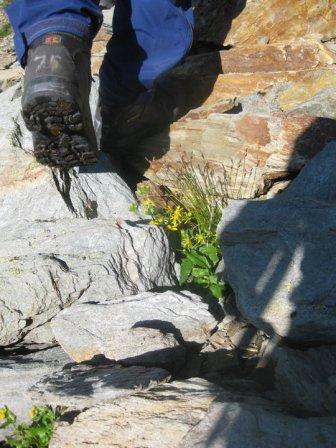Jane Carswell on Wed, Sep 08, 2010
 I led treks and far-flung tours for almost 30 years (for an Adventure Collection sister company of CMH’s), and before we started trekking in Tibet, Nepal, or wherever, I’d tell my clients–many of whom were (almost always needlessly) anxious they’d lag on the trail–that there was much little-known technique to hiking, and that the Rest Step could increase their stamina and enjoyment by, oh, 65%. They’d look at me like I was launching some kind of shaggy dog story, but I wasn’t, and many of them ended up thanking me at trek’s end for my little trail-side seminars.
I led treks and far-flung tours for almost 30 years (for an Adventure Collection sister company of CMH’s), and before we started trekking in Tibet, Nepal, or wherever, I’d tell my clients–many of whom were (almost always needlessly) anxious they’d lag on the trail–that there was much little-known technique to hiking, and that the Rest Step could increase their stamina and enjoyment by, oh, 65%. They’d look at me like I was launching some kind of shaggy dog story, but I wasn’t, and many of them ended up thanking me at trek’s end for my little trail-side seminars.
(Not to get all Zen about it, but you never really master the Rest Step; you develop a relationship with it, and as you grow older, as the terrain seems to get a little steeper every year, your step adapts, and the relationship deepens. I’ve found Heli-Hiking a great laboratory for my ongoing dalliance with the Rest Step.)
To cut to the chase, this is what I’d tell my trek mates: Rhythm is everything. But establishing and maintaining a good rhythm takes practice. Your lungs are smarter than your legs, and you should let your lungs determine your pace, dictating to the legs, not the other way around. (If you watch people hike, you’ll notice that many of them hike with their legs, not with their lungs.)
If you’re walking efficiently, linking your breath with your step, you will burn almost all the oxygen you take in, and if you falter or break rhythm, you’ll often find yourself thrown into (non-dramatic, but noticeable) oxygen debt. (This sense of being a super-efficient furnace is a lot of fun, by the way. The Rest Step discipline is a very fun thing in general.)
It’s very difficult to establish rhythm when your steps are of varying length. So: it’s crucial to take steps of the same length as often as possible (something we tend not to bother with normally). It means looking ahead and locating a good place to put your striding foot, making strong, full-sole contact with the ground whenever possible (this helps avoid what I think of as toe-walking, which wrings the oxygen out of your hamstrings; I will turn my foot quite a bit in order to land it as flatly and firmly on the terrain as possible). When you’re taking steps of roughly the same length each time, you’re able to establish rhythm…and you will naturally begin to take smaller steps (which might mean a little slower, but far steadier pace; some of CMH’s heli-hiking guides call this the Wedding March Step).
And when your steps are regular and fairly short, you’ll notice that you’re able to use your quadriceps, or thigh muscles, less. Many people hike with their quads; they often begin one step before they finish another, and end up using both quads at the same time. If both knees are bent when you’re hiking, you’re using both quads at once, you’re guzzling oxygen and energy like a Hummer guzzles gas. But it’s possible to hike using one quad at a time. How? This is the really subtle aspect of the Rest Step, one difficult to describe. But when you concentrate on taking short, well-anchored, rhythmic steps, you can lock the knee of the striding leg very soon in the step. (And when you lock the knee, and shift your weight onto it, you take weight off the other leg, giving it a moment of rest and relaxation).
When you lock your knee, your push-off should provide enough force and momentum for you to use your leg like a strong pole, coming up and over your well-planted foot and straightened leg with surprisingly little effort…resting, in effect, if only for a short moment. (If you get the hang of this, at the top of the step, coming up and over, you’ll have an instant that feels like real weightlessness. No kidding. Some people worry that all this knee-locking is wearing on these notoriously cranky joints; my experience is that if you avoid snapping into the lock, but do it with respect, there’s little to fear.)
And so: as the left foot, say, is locked and letting momentum do the work, you can use the gluteus muscles–the largest, probably the strongest muscles you’ve got–to swing your relaxed, off leg forward in search of anchorage. One step at a time. Up, lock, relax and swing the other leg, find a trusty anchorage, push off, lock the leg, and on and on. The mantras here are: use your leg as a pole. Shift your weight onto that pole. Avoid using small muscles, which gulp more than their share of oxygen. Use big muscles–the gluteus–whenever possible. Avoid over-depending on your quads (they get enough of a workout already). Learn–this can get wonderfully mystic–to loosen up and rest your legs even while you’re using them (tight muscles soak up more energy than loose muscles.)
I’ve always been a secretly lazy hiker, and the Rest Step has been a boon for me over the years. I’ve discovered gears and gaits and gotten farther and kept happier using it, and I hope you can too.